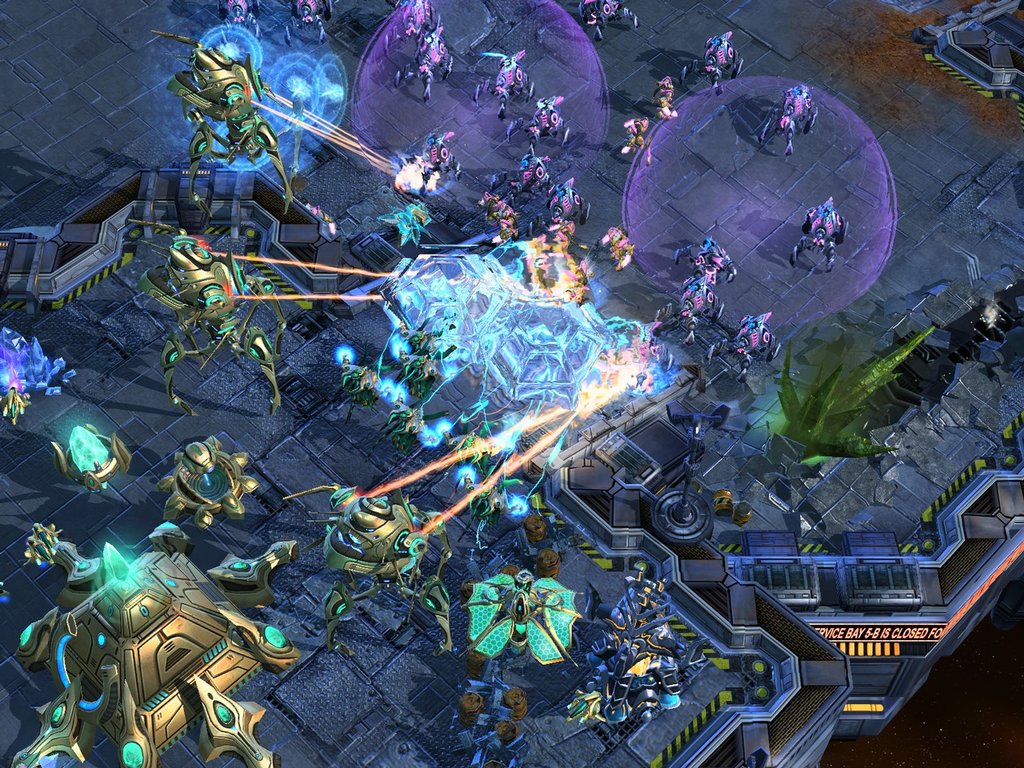For those who dont know in StarCraft II, it's still the Terrans, Zerg, and Protoss clashing against each other, and you're still mining minerals with SCVs, Drones, and Probes and pulling Vespene Gas from the ground to fuel production. It's a classic style of real-time strategy play, one old-school RTS gamers should be very familiar with. Compared to the changes Blizzard made between the traditional gameplay of Warcraft II: Tides of Darkness and the hero-based leveling elements of Warcraft III: Reign of Chaos, StarCraft II feels like a relatively safe play; a game designed to slide in and discreetly supplant its predecessor instead of ruffle the feathers of longtime StarCraft devotees and risk rejection. While it's not a revolutionary game, it is one of the most fully featured, expertly designed, and impressively refined real-time strategy experiences on the market.

Even though at its most basic level a lot of the game is familiar, much has been adjusted. In no area is this more apparent than in the single-player campaign. Blizzard's decision to split the overall story of StarCraft II into three parts sparked some controversy when it was first announced; basically that means you only get to play as the Terran faction (with a few exceptions) for the solo portion, and must wait until later for the Zerg and Protoss campaigns to be released to see the entirety of the story. While that affects some of the impact of the tale, it in no way means you'll be starved for content if all you're looking to do in StarCraft II is play alone. There's a huge campaign here that could easily take many hours to play through (depending on your style and level of difficulty). It's all exceedingly well presented, with a totally reworked narrative delivery system, a few instances of choice driving the story, and options for inter-mission upgrades that make it feel like more of an role-playing experience than a series of mission that exist solely to get you ready for the multiplayer.
Unlike the original game, this time around you won't be staring at the sparsely animated heads of major characters as they bicker and plot on video monitors between missions. Instead, Blizzard gives you a detailed world to play around in to give its fictional universe a greater sense of place and atmosphere. The action follows along with Jim Raynor, who begins the game as a gruff alcoholic in the process of rebelling against Arcturus Mengsk, the corrupt emperor of the Terran Dominion. If you've forgotten the StarCraft storyline or never got around to learning it, then it should be fairly easy to dig into this one, though you're going to miss a lot of references.
Regardless of your level of exposure to the fiction, it's difficult to ignore the eye-rolling cliches and talk of prophecies being fulfilled, and the overabundance of 1980s action movie-style macho posturing and cheesiness. It's all snugly wrapped around the missions though, which makes it easier to look beyond the standard sci-fi trappings and appreciate the detail that's gone into the creation of the character models, the smoothness of the animations, and the amount of character interaction packed into the experience. Since missions are bookended by cut-scenes, great voice acting, and rewards, it makes each feel important in its own way, and adds to your motivation to meet every challenge. It's something a lot of developers besides Blizzard have difficulty doing in this genre, with their missions often feeling like a string of meaningless, boring tasks.

Additional narrative is also provided through interactive environments between missions. You're able to explore various settings, from a dusty building at the campaign's outset to Raynor's starship, the Hyperion, and beyond as the action continues. Eventually the entirety of the game's options and locations are unlocked, letting you flip around to different areas of the ship to talk to major characters or purchase upgrades. On top of that, new units are unlocked depending on which mission you choose to take on next, which can be further modified in the upgrade center, adding significant bonuses to each like more effective healing for medics or boosted protection for Marines. Because the campaign isn't tied down by the strict rules of multiplayer balance, this also means you'll see a number of favorites return from the original. Firebats, Vultures, Goliaths and more can be unlocked and upgraded in the story mode, which is both a great nod to fans and adds more variety for new players. It's a system that's constantly giving you new things to play around with and ways to modify what's already available, making progressions more exciting.

As if that wasn't enough, even more options for army customization exist throughout the campaign, including a research system and mercenary units. These mercs can be hired by Raynor for a fee, and when deployed in battle serve as elite versions of existing units that are called in instantly. It can be great in a bind, and adds to the stable of available fighters when setting up a battle plan. Optional objectives in missions call for the collection of Protoss or Zerg research items, which can then be turned in between stages for even more upgrades. Along both Zerg and Protoss paths these upgrades exist in pairs - where selecting one locks out the other - meaning you'll have to make permanent decisions about things like whether you want to buff the armor of a Bunker or slap a gun turret on top. All these modification systems combined make for a highly customizable campaign experience that's consistently fun because it introduces a steady stream of new content and options, making sure there's always something to look forward to trying out for the first time.
No comments:
Post a Comment